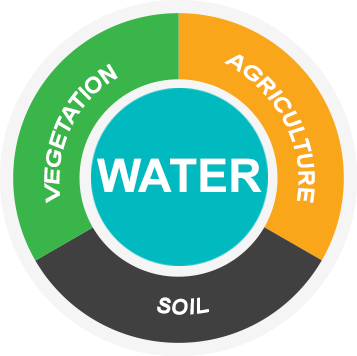We promote the restoration of native vegetation and sustainable agriculture in areas identified as critical in river basins.
These actions bring long-term benefits to society and its environment, minimizing the risk of climate impacts such as droughts and floods, recovering water availability, soil productivity, while conserving biodiversity and generating income.

IBIO is a technical institution focused on solid results, which generate positive impact for the environment and human well-being on the long term. Our strategies are established on these premises, and in addition to our values they guide the actions and institutional relations with the main stakeholders.
For us to fulfill our mission, we have adopted the adaptation strategy as methodological basis, as promoted by the main multilateral organizations. “Investing in adaptation and resilience demands knowledge of the main causes of the observed impacts and their locations.” (European Community, 2013; IPCC 2014; USAID 2015)
Adaptation Strategy
The adaptation strategy has as goal to mitigate and minimize the risks of occurrence of impacts related to critical climate events, which affect the environmental quality and the economic competitiveness of a hydrographic basin.
1
Identification of critical areas, impacts and causes

2
Design of the adaptation actions

3
Structuring of the monitoring system and evaluation

4
Strengthening of the territorial management system

5
Investment prioritization plan


Our strategy is to generate measurable results which adapt watersheds and river basins to future climate conditions. For this process, we have adopted the adaptation strategy as a methodological basis, as have other major global organizations. “Investing in ecological adaptation and resilience requires knowledge of the main causes of the observed impacts and their locations.” (European Community, 2013; IPCC 2014; USAID 2015).
The adaptation strategy is focused on the identification of critical areas (1), and understanding of the impacts and their causes. We do this through models that assess vulnerabilities in the basin. The most vulnerable areas are the most critical.
A number of actions (2) are necessary in order to reduce vulnerability. IBIO works preferably with those that use natural infrastructure to regulate the quantity and quality of water, therefore conserving soil and biodiversity—the so-called environmental services.
The actions we operate with most are:
Native vegetation restoration
Pasture management
Agroforestry
Rural sanitation
The first three are green or natural infrastructure, designed to recuperate conditions for soil coverage with vegetation, and thus readjust the landscape of watersheds. Rural sanitation, an example of gray infrastructure, prevents the pollution of rivers and groundwater. Farmers and rural producers are our main partners in this effort.
To ensure that actions are being carried out properly, it is necessary to monitor and evaluate indicators (3) which clearly show us the evolution of the projects as well as positive and negative impacts on the basin.
IGEO is IBIO’s Geospatial Intelligence tool developed for the purpose of planning, monitoring and evaluating the territory. The basis of IGEO is an information and indicators framework that gives us the ability to measure the efficiency of investments, the progress of actions and the effectiveness of results.
IBIO is a technical organization that supports decision-making processes in both public and private sectors. Because we work with river basins, our understanding of territorial management (4) considers the Comitê de Bacias (River Basin Committee) as the most legitimate forum for negotiated decisions among the various sectors of society.
Therefore, the success of our strategy depends crucially on the existence of consolidated and empowered committees to make technically well-informed decisions on key issues concerning watersheds and river basins.
IBIO works as Water Agency to strengthen the Rio Doce Committees
The adaptation strategy aims to provide the committees with a Priority Investments Plan (5), indicating adaptive actions that will provide the best returns at the lowest cost, while minimizing vulnerabilities in the river basin and watershed. The goal is to enable decision makers with a technical ground and a monitoring system to check the results.

A Bacia do Rio Jucu é responsável pelo abastecimento de grande parte da região metropolitana da Grande Vitória e, assim como a maioria das bacias hidrográficas do país, teve sua capacidade hídrica seriamente comprometida. Por essa razão, um projeto liderado […] more